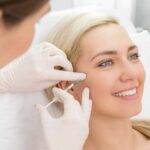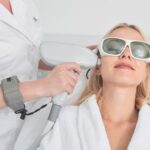
Aesthetic medicine has witnessed a remarkable surge in demand among younger millennials and Generation Z in or entering their 20s. These demographics exhibit unique characteristics and preferences regarding their appearance and are already concerned about how to look younger in their 20s.
Doctors can offer informed, effective, and patient-centric solutions for this group of patients only by understanding their specific concerns and motivations and the evolving trends in the aesthetic landscape.
Aesthetic Concerns in the 20s
Aesthetic concerns in the 20s encompass a diverse range of dermatological issues, cosmetic aspirations, wrinkle prevention, and psychosocial factors. Recognizing and appreciating skin-related concerns that drive young adults to seek aesthetic interventions is crucial.
Common skin issues:
- Acne and post-acne are a persistent concern among patients in their 20s.
- Uneven skin tone, hyperpigmentation, rough skin texture, and enlarged pores.
- Fine lines and early signs of aging.
Younger millennials and Gen Z are digital natives, heavily influenced by social media platforms. The prevalence of filtered images and curated online personas has heightened aesthetic consciousness and contributed to an increased interest in cosmetic procedures. In this digitally driven era, adequately addressing patient motivations and fostering realistic expectations is especially important.
Aesthetic distress can exert a profound psychological impact on young adults. Low self-esteem, body image issues, and anxiety related to appearance are prevalent. This underscores the significance of empathetic patient-provider interactions, reinforcing the need for a holistic approach to beauty routines and treatments.
Recommendations for Aesthetic Treatments and Skincare
The heart of this article lies in understanding and elucidating the diverse recommendations for aesthetic treatments and skincare specific to patients in their 20s. Let us delve into this complex subject with an in-depth exploration.
Skincare Routine for People in Their 20s
Customized skincare regimens form the cornerstone of aesthetic care for young adults, and dermatologists play a crucial role in guiding patients toward optimal skincare practices.
Prescribing tailored skincare routines that encompass cleansing, moisturizing, and targeted treatments is essential.
Preventive anti-aging skincare recommendations for young adults:
- Sunscreen and UV protection are paramount in preventing skin cancer and early aging. Doctors must encourage their young patients to use broad-spectrum, high-SPF sunscreens.
- Antioxidants like vitamins C and E are pivotal in photoprotection and collagen stimulation. Advise patients on the benefits of incorporating antioxidant-rich serums into their daily regimen.
- Retinoids, available as prescription and over-the-counter formulations, are powerful tools for maintaining youthful skin. They enhance collagen production, promote skin turnover, and can effectively address early signs of aging.
- Adequate hydration is fundamental to skin health. Hyaluronic acid-based products provide deep hydration, ensuring skin plumpness and radiance.
- Exfoliation with alpha hydroxy acids (AHAs) and beta hydroxy acids (BHAs) maintains skin texture and promotes cell turnover.
Non-Invasive Aesthetic Procedures
Non-invasive procedures offer a range of options to address specific skin concerns. These procedures particularly appeal to young adults who seek results without the downtime associated with surgical interventions. Examples of non-invasive anti-aging procedures:
- Chemical peels, available in varying strengths and formulations, can effectively target issues such as acne, pigmentation, and fine lines. The choice of peel should be tailored to the patient’s skin type and specific concerns.
- Microdermabrasion is an exfoliation technique that enhances skin texture and tone. It can be a valuable addition to skincare regimens, promoting the penetration of topical products.
- Laser treatments, including fractional lasers and intense pulsed light (IPL) therapy, offer precise solutions for various skin issues. These modalities can address acne scars, pigmentation irregularities, and vascular lesions.
- Microneedling procedures stimulate collagen production and enhance skin texture. When combined with growth factor serums, microneedling can expedite the repair and rejuvenation of the skin, preventing wrinkles in the 20s.
Injectable Treatments
Young adults increasingly seek injectable treatments to address specific aesthetic concerns. Skin treatments for anti-aging purposes include the following:
- Botulinum toxin injections, commonly known as Botox or Xeomin, can address dynamic wrinkles and provide subtle facial contouring. Young adults may seek these treatments for preventive purposes.
- Dermal fillers can enhance facial volume, address under-eye hollows, and create subtle enhancements. They offer natural-looking results and are particularly popular among young adults seeking non-surgical facial rejuvenation.
A thorough medical history assessment of the patient is mandatory, including checking for allergies and contraindications for specific treatments. Identifying potential risks and determining the patient’s suitability for each procedure is the first step in ensuring safety. Conditions such as autoimmune diseases or immunosuppressive therapy may influence the choice of treatments or require special precautions.
In cases where patients may have heightened sensitivity or risk of allergic reactions, performing patch tests can provide essential insights into their suitability for particular treatments and skincare products.
Combination Therapies for Optimal Results
Aesthetic doctors must highlight the potential benefits of combining multiple treatments to achieve synergistic results. For instance, microneedling followed by the application of growth factor serums can enhance collagen production and skin rejuvenation more effectively than individual treatments.
Combination therapies are particularly advantageous for addressing multifaceted concerns. They allow for a holistic approach, simultaneously targeting issues like acne scarring, early signs of aging, hyperpigmentation, and skin laxity.
Doctors also must recognize the unique skincare needs of patients with diverse ethnic backgrounds and tailor treatment plans to address concerns related to pigmentation, scarring, and specific skin conditions more prevalent in certain ethnic groups.
By offering individualized treatment plans, healthcare providers can maximize the efficacy of aesthetic interventions while ensuring patient satisfaction and safety.
Conclusion
Aesthetic medicine is witnessing a paradigm shift, with millennials and Generation Z leading the demand for innovative anti-aging procedures and skincare solutions. Understanding these patients’ unique concerns, motivations, and preferences is critical to providing effective care.
In this era of evolving aesthetic preferences and trends, doctors can empower patients in their 20s to look and feel their best while prioritizing their overall well-being and meeting the demands of this dynamic and forward-thinking demographic.
FAQ
Is 20 too late to start skincare?
Beginning a skincare regimen in an individual’s 20s can be highly beneficial in preventing premature aging and maintaining healthy, youthful skin. Here are several reasons why starting skincare in your 20s is a smart choice:
- Starting skincare in the 20s allows a proactive approach to prevent early signs of aging. Maintaining healthy skin is easier than reversing significant damage later in life.
- Establishing a habit of daily sunscreen use at this age can significantly reduce the risk of sun damage, fine lines, and sunspots, preventing wrinkles in the 20s.
- Collagen production in the skin naturally begins to decline in one’s late 20s. Initiating skincare that includes collagen-boosting ingredients like retinoids can help slow this decline and maintain skin elasticity.
- Starting a beauty routine at this age helps establish good skincare habits that can benefit a person for a lifetime. Consistency is key; forming these habits early makes people more likely to maintain them as they age.
A well-structured skincare routine can help prevent future skin issues like hyperpigmentation, fine lines, and early signs of aging like forehead wrinkles at 20.
In summary, starting a skincare routine in the 20s is wise. It allows patients to take proactive steps to prevent skin issues, protect against sun damage, opt for preventive wrinkle treatments, and maintain youthful, healthy skin.
How can my patients prevent skin aging in their 20s?
Preventing skin aging in one’s 20s involves adopting a proactive approach to skincare and lifestyle choices. Here are essential anti-aging tips for your patients in their 20s to help them maintain youthful, healthy skin:
- Daily sunscreen application with a broad-spectrum SPF of at least 30 can protect against UV radiation, the primary cause of early skin aging, including wrinkles, sunspots, and sagging skin.
- Daily skincare regimen that includes cleansing and moisturizing. Recommend gentle skincare for young people and get them to avoid harsh, abrasive scrubs that can damage the skin barrier. A healthy skin barrier is essential for retaining moisture and preventing premature aging. Additionally, recommend specialized products like antioxidant-rich serums (e.g., vitamin C) and retinoids to boost collagen production and fight early signs of aging.
- Adequate hydration is essential for healthy skin. Encourage patients to hydrate, as drinking enough water helps maintain skin elasticity and suppleness.
- Get patients to avoid smoking and limit alcohol intake, both of which accelerate skin aging by causing collagen breakdown, dehydration, and reducing blood flow to the skin.
- Advocate for a diet rich in fruits, vegetables, lean proteins, and healthy fats. These provide essential nutrients like antioxidants, vitamins, and omega-3 fatty acids, which support skin health.
- Regular exercise enhances circulation and helps reduce stress, a common factor in premature aging.
- Patients need to prioritize sleep and stress management.
- Limit sugar and processed foods, which contribute to skin inflammation and premature aging.
- Inform patients about the risks of tanning, whether natural or artificial. UV exposure from tanning can cause irreversible skin damage and increase the risk of skin cancer.
Consistency is vital in skincare. Encourage patients to stick to their skincare routines and not skip steps, especially cleansing and moisturizing.
Encourage patients to schedule regular skin check-ups with a dermatologist. Early detection of skin issues, such as melanoma or other skin cancers, is crucial for effective treatment.
References
Ganceviciene R, Liakou AI, Theodoridis A, Makrantonaki E, Zouboulis CC. Skin anti-aging strategies. Dermatoendocrinol. 2012;4(3):308-319. doi:10.4161/derm.22804.
Rattan SI. Anti-ageing strategies: prevention or therapy? Showing ageing from within. EMBO Rep. 2005;6 Spec No(Suppl 1):S25-S29. doi:10.1038/sj.embor.7400401.
Eassa HA, Eltokhy MA, Fayyaz HA, et al. Current Topical Strategies for Skin-Aging and Inflammaging Treatment: Science versus Fiction. J Cosmet Sci. 2020;71(5):321-350.
Shanbhag S, Nayak A, Narayan R, Nayak UY. Anti-aging and Sunscreens: Paradigm Shift in Cosmetics. Adv Pharm Bull. 2019;9(3):348-359. doi:10.15171/apb.2019.042.
Kaeberlein M, Rabinovitch PS, Martin GM. Healthy aging: The ultimate preventative medicine. Science. 2015;350(6265):1191-1193. doi:10.1126/science.aad3267.
Injectable aesthetics are popular due to their ability to provide noticeable results with minimal downtime compared to surgical procedures. They are versatile and can be tailored to meet individual aesthetic goals, whether it's enhancing lips, restoring facial volume, or smoothing out wrinkles. However, they should always be administered by qualified professionals to ensure safety and achieve optimal results.
Injectable aesthetics are used to enhance facial features, reduce the signs of aging, and improve overall facial symmetry and appearance.
Key types of injectable aesthetics include:
-
Dermal Fillers: These injectables are used to add volume, fill in wrinkles and folds, and enhance facial contours. They often contain substances like hyaluronic acid, collagen, or calcium hydroxylapatite, which help plump up the skin and smooth out fine lines and wrinkles.
-
Botulinum Toxin (Botox): Botulinum toxin injections temporarily relax facial muscles that cause wrinkles and lines to form. It is commonly used to treat forehead lines, frown lines between the eyebrows, and crow's feet around the eyes.
-
Collagen Stimulators: These injectables stimulate the body's own collagen production, helping to improve skin texture and firmness over time. Examples include poly-L-lactic acid (Sculptra) and calcium hydroxylapatite (Radiesse).
-
Neurotoxin Injections: Besides Botox, other neurotoxins such as Dysport and Xeomin are used similarly to reduce wrinkles and lines.





